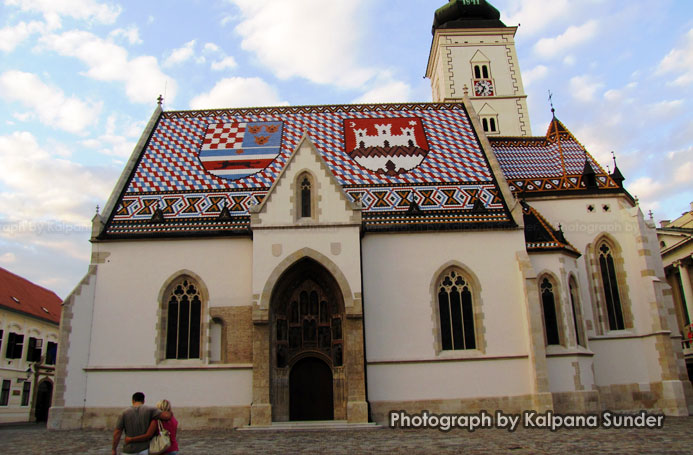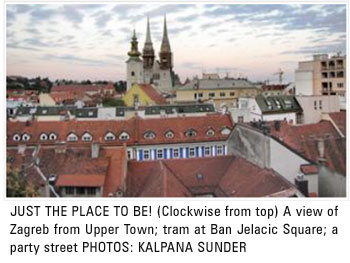
 HOLIDAY Fashion hoardings, galleries, street musicians, green spaces… Croatian capital Zagreb is a wonderful medley of the old and the new, discovers KALPANA SUNDER
HOLIDAY Fashion hoardings, galleries, street musicians, green spaces… Croatian capital Zagreb is a wonderful medley of the old and the new, discovers KALPANA SUNDER
It's easy to forget that the journey is as important as the destination itself. We are a bunch of people exploring the Eurail network over Croatia and Slovenia. The Adriatic coast has been done, and we are on our way to Zagreb. The Zagreb station is a stunner, and our first impression is that Zagreb's a green city. The town planners had the foresight to create green spaces between building blocks. We walk along the most impressive green lungs — Lenuci's horse shoe, named after the man who planned this network of gardens, galleries, statues and peach and yellow buildings. There are luxuriant flower beds, a leafy promenade, and busts of prominent Croatian personalities. Couples are cosying up, joggers and dog walkers pass us by and boisterous kids with helmets ride their bikes. Ahead is the ornate Croatian National Theatre, with a circular pool called the Well of Life. This is famous Croatian sculptor Mestrovi's work with a bronze frieze of intertwined nude figures reaching for the water. Appropriate for a city with a zest for life! One sunny day, a brave Croatian leader returning from battle, asked a girl called Manda to ladle (zagrabiti in Croatian) him some water from the spring. This spring became Mandusevac, and the city Zagreb.
Swarming with people
I watch modern fashionistas and children swarming around this famous fountain in the famous Ban Jelacic Square. A huge equestrian statue of Josip Jelacic, a 19th Century hero, who abolished feudalism, dominates the plaza. Bright blue futuristic trams whiz past. Concert posters and huge fashion hoardings dominate the background. This is the centre of Zagreb's gregarious social life — where people hang out and meet over kava or coffee. Zagreb today, is an amalgam of Gradec and Kaptol (Upper Town), the Lower Town and the post-war modern Zagreb. Zagreb is fortunate to have Mt. Medvednica on its doorstep. It's a popular weekend destination for locals to go trekking and skiing. This is a city made for strolling, people in cafes listening to street musicians. The Cathedral of the Blessed Mary is a defining symbol of this city with its sandstone façade, which has seen its share of wars and fire. It was destroyed by an earthquake in 1880. Viennese celebrity architect Herman Bolle gave it this new look with twin spires dominating the skyline. Traces of the medieval walls and round towers still remain, giving it that back-in-time feel!
What used to be a stream long ago separating the settlements of Kaptol and Gradec is today a sea of tables and chairs and trendy high-on-caffeine voyeurs. The ‘party street' Tkalciceva is also the favoured spot for a Saturday ritual called spica. Read newspapers, sip on coffee, pick up fresh vegetables from the Dolac open market, and head home! We come to the Stone gate — the only surviving 13th Century entrance to the old town with a walk-through open-air chapel. It holds a painting of the Virgin Mary and Jesus that escaped a fire miraculously. Dark interiors, whispered voices and a few pews — this is just the place to light a candle and make a wish! Gradec, the haunt of artisans and merchants in medieval times, is a step back in time. You will see two people patiently light the gas lamps in this maze of cobblestone streets and Baroque palaces — there are over 200 such lights in this city. St. Mark's Church and its brightly-tiled roof decorated with a medieval coat of arms leap out at me, ablaze in the burnished orange of the setting sun. It provides a glorious touch of warmth to an austere square containing the Presidential palace, the city hall and the Parliament building.
Back in time
At the corner, is a stone hewn face of Matija Gubec, who led an uprising of Croatian peasants, and was executed in St. Mark's Square. Ahead is the white-washed Lotrscak Tower, the defence tower of the town in the 13th Century. The Strossmayer Promenade here is lined with dense chestnut trees, and I suddenly catch sight of a sculpture cast in bronze sitting on a bench — of poet and dreamer Antun Matos. From here we can see the 100-year-old funicular trundle up from Ilica, the shopping mile crammed with boutiques. Shops in Zagreb sell a red, heart-shaped ornament. They are Licitars, objects of affection. They used to be made of gingerbread and decorated with flowers and mirrors. Cravats or ties are sold everywhere. The story goes that the French mis-pronounced Croats as Cravat, and the rest is history! I am fascinated by the naive art on offer. It's a distinctive technique of painting, on glass, of bucolic scenes full of colour and strange representations almost child-like in form. Zagreb even has a museum dedicated to this art form. And, when your feet are tired with all that walking and shopping, Slavic schnapps or mistletoe grappa is a good idea as well as the Strukli-dough rolled and filled with cream and cheese. Lingering over dessert, I realise Zagreb's found a place in my heart. Wish I had a day more!
Published in The Hindu Metro Plus 2011

